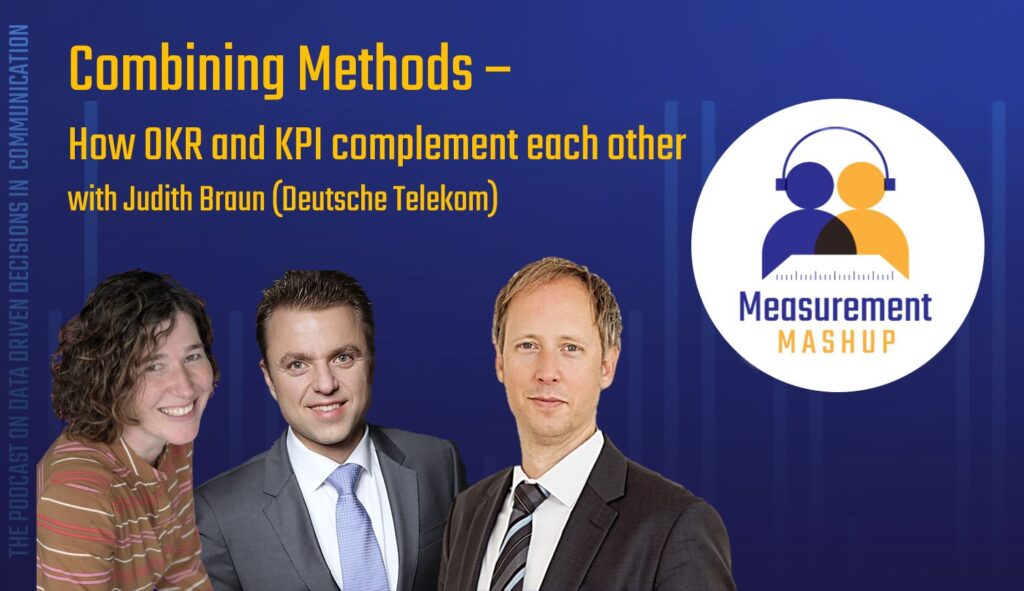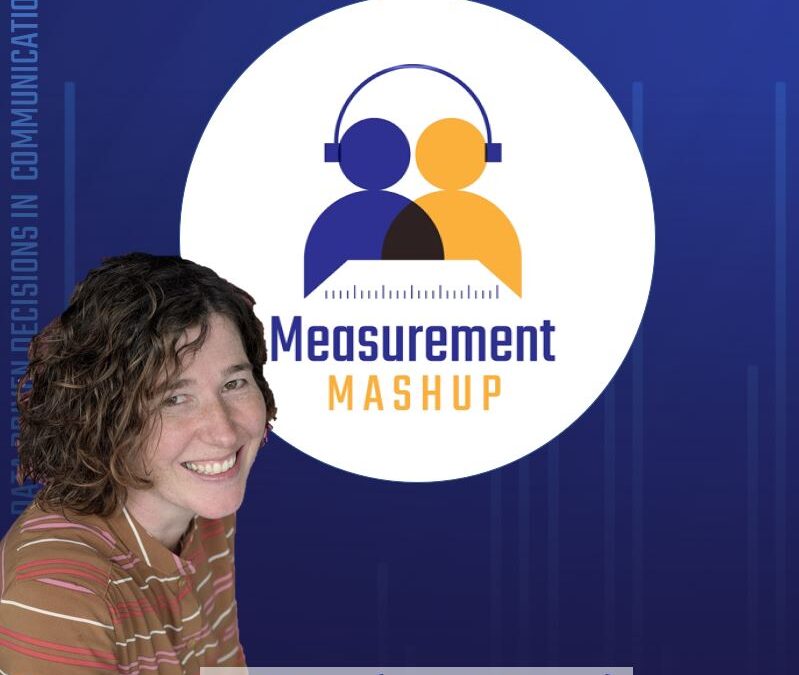We discuss how Objectives and Key Results (OKR for short) and communications controlling are connected with Judith Braun. She works as an OKR architect in corporate communications at Deutsche Telekom and is a multi-method mixer. She became involved with OKR because of her affinity for agile methods. Looking back on her long experience with the method, what does she like so much about it? We talk about what you have to be prepared for when you align your team with it and whether Communications Controlling and OKR are mutually exclusive or complement each other in a useful way.

Shownotes | About Judith Braun| Submit a comment
Judith Braun has been at Deutsche Telekom for 30 years. Started in the civil servant talent pool with a degree in administration, she is now a senior expert in communications. In between, she has worked for many years with agile methods, Scrum, Design Thinking, OKR and, in general, New Work. Today, she leads a team of six OKR coaches at Telekom.
OKR – new management method or miracle cure for organizations?
OKR is short for Objectives and Key Results. Any type of company that follows a vision faces two obstacles, says Judith Braun: scarce resources and a dynamic and complex environment. Braun compares this to a large meadow of flowers for which only a small watering can is available: you can’t water all the flowers sufficiently. OKR helps to make the best possible decisions in such situations. Which approaches should be cultivated and what expectations are attached to this decision? In the context of communication, this means: Which messages do you focus on, and how should they be received by the audience? The ensuing active decision not to engage in certain activities can be painful.
“OKR is first and foremost a framework for critical thinking and good discussions” Judith Braun
However, Braun considers the development of Key Results to be even more exciting and difficult than setting objectives. The Key Results define success factors with which the respective objective can most likely be achieved. In the team, a common understanding of what success looks like and what the best way to achieve it is must first be created. Taken together, this results in a micro strategy.
Relation to other Agile Methods
Both Scrum and OKR are agile working methods. They follow short cycles of learning and experimentation with frequent meetings to check whether the path taken is the right one.
OKR, he said, is strategically one level higher because it deals with direction, success factors, goals. In OKRs, no measures or to-do lists are formulated. This can be done well in Scrum, with other agile methods such as Kanban, but also with classic project management or hybrid methods, says Judith Braun.
At the beginning of the fiscal year, for example, it is determined that brand awareness and knowledge of the company’s service portfolio should be increased in a certain target group. The individual teams – e.g., communications, marketing or IT – would derive what should have changed in their area at the end of the first cycle in terms of brand awareness and how they would notice that they had successfully increased it, Braun explains. In most cases, he says, the year is broken down into four cycles, or three-month periods. Each team would define the success factors for the next period – for example, do they need training or multipliers to move forward? Once the OKRs are defined in this way, then the project can move into project work.
Integrating many Departments vs. Silo Mentality
In contrast to traditional management by objectives, OKR documents all steps transparently for everyone, from the coordination rounds to the drafts and the results, says Braun. In her projects, there is also a monthly meeting where people can ask questions and overcome different points of view. The platform for documentation doesn’t matter. The main point is that everyone can access it at any time. A digital or agile work culture is a good prerequisite for finding a suitable type of documentation.
Looking at the key results makes it easier for departments to part with cherished, ineffective activities. If the necessary results don’t materialize, at some point it takes a heart-to-heart conversation and the realization that an activity may have had its day, but is no longer helpful for the current goals and framework, Braun says.
Key Performance Indicators and Key Results – differences and correlations
Similar to communications controlling, OKR therefore involves the strategic agreement and pursuit of goals. How do the two models relate to each other? The impact level model in communications controlling defines different levels, roughly input, output, outcome and outflow. Or, as Braun puts it, communication takes place, is recognized, accepted, and has an influence on attitudes and opinions. OKR focuses on the right side of the model: the agreed objectives must be at the outcome level and not already at the output level in the case of clicks or visits.
“OKR are like a GPS into a dynamic complex future.” Judith Braun
A Key Result shows the success factors that have the greatest probability of a goal being successful in the first place, explains Judith Braun. A KPI, on the other hand, shows with a time delay whether the activities have been successful.
It is important for OKRs to target a dynamic, complex future situation that cannot be predicted, not even with a great deal of expertise. Braun talks about using OKR to err together toward the goal in a structured and success-oriented way – which is why the short cycles for course correction are necessary.
KPI would rather indicate whether and how the underlying business is currently running. It is often easier for companies or departments that already work with KPI to get started with OKR because many basic considerations have already been made.
Especially for companies that already monitor many KPI, one OKR use case could be to bring deviating KPI back into the green corridor. Another use case is a “moonshot” – a situation in which you have to think big and off the beaten path, out-of-the-box. With OKR, you can work on large-scale solutions in a cycle with the joy of experimentation and the possibility of failure.
Key Results and Metrics
Listening to Judith Braun, it becomes clear that key results do not need report metrics that have to be well presentable in order not to make a bad impression on the boss. In connection with Key Results, she talks about learning metrics – either you win or you learn something. Especially riskier goals, where the focus is on experimentation, you have to deal openly and honestly with dead ends in order to be able to change course.
Agile meeting culture
When introducing OKR, you should also put your existing meetings to the test so that the introduction does not fail due to “too many” meetings. Sometimes old formats are no longer necessary or can be merged with OKR meetings.
As an agile exchange format, OKR meetings are very concise and structured. Only the people who add value come together, and there’s no free talk, just clarification of four questions, Braun says:
- Is there progress on the particular Key Result?
- Have there been obstacles?
- Are you confident to reach the result by the end of the cycle?
- What top prio measures are on the table until the next meeting?
Telekom’s internal OKR coaches accompany and train the teams until they have mastered the cycle and can operate the processes autonomously.
Typical teething problems
No matter how well you prepare for the switch to OKR, experience shows that you always fall flat on your face in the first few cycles, says Judith Braun. It’s not so easy to get out of an output mindset and to stop formulating your key results as to-do lists. Obviously, everyone has to go through this learning process first, and this difficulty should be openly communicated in the first few months.
In her experience, the biggest challenge is balancing fidelity to the principles of the method with pragmatic adaptation, Braun says. OKR is the most poorly documented agile method, she explains, and thus leaves a lot of freedom. And, of course, there would be no standard solution for everyone. On the other hand, you have to stick to a few methodological cornerstones if you want to tap into the method’s benefits for yourself:
“Don’t argue with the scale if you want to lose weight.” Judith Braun
She says it’s important for teams to develop appropriate structures and use the occasions for good conversations. Judith Braun tells us that they have reduced from the classic four annual cycles to three, because otherwise the workshops always were scheduled during the vacations. And that they had built a wonderful Excel template for documentation, but hardly any teams used it because of its complexity. Now the teams would walk through the meetings with a template chart featuring the four main questions and then document the results independently.
Benefits of switching to OKR
“… for collaboration especially in large companies along value chains rather than departmental boundaries, the method is really wonderful for that.” Judith Braun
The first quick win was greater transparency, says Judith Braun. Employees found it very helpful to come together once a cycle, name the focus points and be in constant communication via the review-retro structure. Braun describes how this structure also enables much more internal connection and collaboration across departmental boundaries and helps break down silos: Departments are now working together on “shared key results.”
Shownotes
Judith Braun’s recommendations for anyone who would like to know more about the topic:
- Virtual regulars’ table: anyone who is an OKR user in a group or larger company is welcome to contact Judith Braun if they are interested in a regular, group-wide community of practice.
- International OKR expert Felipe Castro
- Great blog about OKRs (in German language)
- Johannes Müller from Workpath about OKR (in German language)
- Murakamy’s AskMeAnything sessions are great to listen to and you can always sign up to participate yourself as well (in German language)
About Judith Braun
After starting her career in sales marketing, Judith Braun worked for several years in event management at Deutsche Telekom. For a while, she looked after a record label on Portobello Road in London and organized tours worldwide. Back in Germany, she returned to Deutsche Telekom, where she was involved in the design and implementation of customer events and developed a Group-wide event scorecard. Today, as a senior expert in communications, she is responsible for Deutsche Telekom’s digital transformation, new work and communications strategy.

